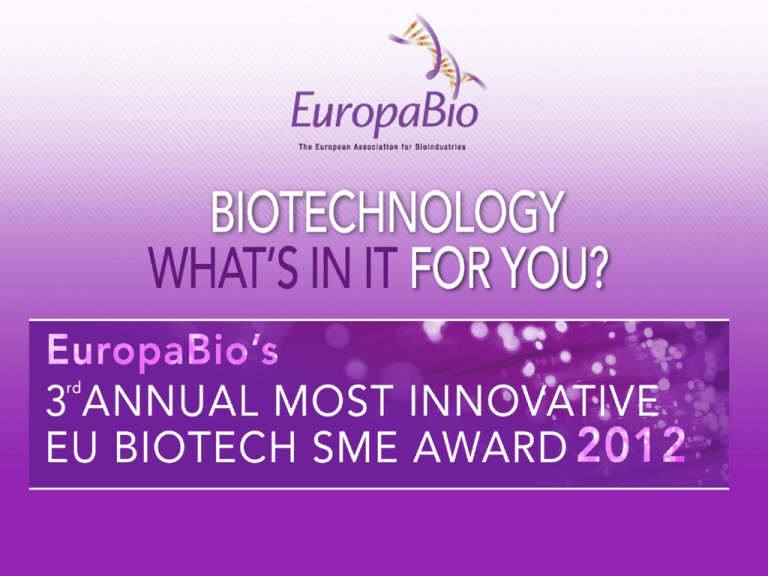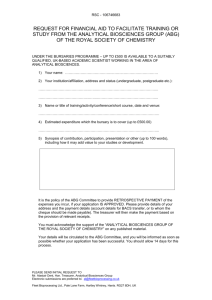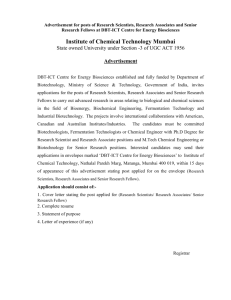Diapositive 1
advertisement

Introduction Nathalie Moll, Secretary General EuropaBio Dr. Philippe De Backer, MEP 2 Company highlights: Global Bioenergies Jean-Babtiste Barbaroux, Head of Corporate Development 3 Direct gaseous fermentation to isobutene, a platform molecule for drop-in chemicals and fuels Brussels, Sept. 19th 2012 Global Bioenergies at a glance • Established in 2008 by Marc Delcourt, a seasoned entrepreneur in industrial biology and Philippe Marlière, a pioneer in synthetic biology • Located close to Paris in Genopole, the number 1 biotech cluster in France • A team of 30 people gathering multidisciplinary skills • International Scientific Advisory Board • Successful IPO on Alternext mid June 2011 and subsequent capital increase of 3M€ in June 2012. • Collaborations with Synthos, LanzaTech, a German car manufacturer and a Major US industrialist 5 Mission statement Converting renewable resources into light olefins through direct fermentation 6 Why is it interesting ? • Because these molecules are the key building blocks of the petrochemical industry • Huge markets – wide product trees – drop in Existing Market (b$) Potential Market (b$) Main applications Ethylene 144 Polyethylene (60%) Propylene 88 Polypropylene (65%) 37-74 Co-monomers in various plastics Linear butenes Isobutene 29 Butadiene 14,6 Isoprene 2 >400 Tires, organic galss, pET, fuels Tires, nylon, coating polymers 10 Tires, adhesives 7 Diverse feedstocks… Sugar Starch 170mT 2.070mT Ligno-cellulose To be industrialised in the near future CO (+H2) Potential x10.000mT Corn Sugar beet Steel mills Forestry waste Straw Wheat Municipal waste Sugar cane Energy crops Rye, rice, barley, Potatoes…. Biomass (all types) 8 …transformed into isobutene… high purity Isobutene Low quality Glucose Genetically engineered micro-organism Reduced costs and improved environmental impact due to: - No product toxicity, no feedback-inhibition no back-flux, - No distillation nor liquid to liquid extraction 9 Issues with classical approaches yielding a liquid intermediate molecule as the fermentation product • Fermentation product = liquid (isobutanol, ethanol, butanediol..) accumulation in fermenter toxic for micro-organism at certain concentration (e.g. 4% for iso-butanol) requires costly distillation or phase separation • Fermentation product needs to be chemically transformed (e.g. through dehydration) into final product cost in terms of OPEX and CAPEX possible source of isomer impurity generation DIRECT fermentation to the final, GASEOUS end-product avoids those issues 10 Isobutene industrialization schedule 1 August 2012 : - more than half of the development has been accomplished 1 - start of industrialization: laboratory pilot, subsequently industrial pilot 11 The profitability question • “ At what price for the oil barrel is your process going to be profitable ?” • With current molasses prices and targeted process parameters, cost for GBE bio-isobutene (including Capex depreciation) would be below 1500$/t compared to 1750$/t for fossil-based high-purity Isobutene. • Cost structure says it also heavily depends on the cost of feedstock two dimensional analysis. 12 Commodity Chemicals Bio-isobutene price = fossile high-purity isobutene price 600,0 Sugar beet No profit area Sugar cane 500,0 1996 2005 Cost of raw sugar ($/ton) 1995 400,0 1994 1993 1992 2003 2004 1991 2011 1997 1998 1999 300,0 2010 2009 2001 2000 2002 1995 2011 2008 2005 1994 1993 1992 2003 1991 2002 1999 100,0 2009 2006 2008 1997 1996 1998 200,0 2006 2007 2007 2010 2001 2000 PROFIT AREA Commodity Chemicals 2004 0,0 0 20 40 60 80 100 120 140 160 180 200 Price of oil ($/baril) 13 Fuels • Fossil fuels have a price close to the price of oil (1$/kg) • In the near future, cost-competitiveness of biofuels vs. fossil fuels will be difficult to reach • Therefore governments have installed biofuel quotas • Within this “quota market”, Global Bioenergies’ biofuels are more cost- and energy efficient to produce due to the gaseous fermentation process have a high energetic density due to the absence of oxygen atoms are 100% drop in (IsoOctane vs. Ethanol or Isobutanol) present a much better energy/hectare yield than vegetable oil based Diesel/Jetfuel 14 General Business Model • Out-licensing model combining upfront-fee and royalties • Licenses are application specific, normally exclusive (for a determined duration) and possibly geographically limited Example: “Exclusive license for MMA derived from bio-Isobutene for the APAC market (independent on production location)” • Early collaboration in the form of license options allows to - secure rights vs. competitors - faster time to market due to involvement in purification requirements - lower future upfront and royalty payments 15 Contact: Jean-Baptiste Barbaroux Head of Corporate Development 5 rue Henri Desbruères, 91000 Evry, France Email: jean-baptiste.barbaroux@Global-bioenergies.com Tel: +33 (0)1 64 98 20 50 Web : www.global-bioenergies.com Company highlights: Green Biologics Dr Edward Green, CEO 18 Company highlights: Promethera Biosciences Eric Halioua, CEO 27 Cell therapy for genetic and orphan diseases: Promethera Biosciences’ value proposition E. Halioua (CEO) EuropaBio’s Most Innovative European Biotech SME Award September 19, 2012 eric.halioua@promethera.com Tel: +32 474 05 78 66 1. Strategy and Development Plan Promethera Biosciences is a cell therapy company dedicated to the treatment of liver diseases. ONE SINGLE MISSING ENZYME CAN HAVE A DRAMATIC CONSEQUENCE ON THE QUALITY OF LIFE INBORN ERRORS OF LIVER METABOLISM (Crigler-Najjar Disease ) - Orphan diseases: < 1/5000 to 1<2000 Most young patients have only very limited therapeutic options and may die at an early age Only a few % of enzymatic activities makes a drastic difference in the quality of life 29 1. Strategy and Development Plan With Promethera’s process, with one liver hundreds of patients can be treated. DRUG SUBSTANCE Raw Material Normal Adult Human Liver Human Hepatocytes Isolation of human hepatocytes from the liver Enzymatic and mechanical dissociation of parenchymal cells Purification of HHALPC from mature liver cells HHALPC in culture Larger Volume of HHALPC In vitro expansion DRUG PRODUCT INJECTION HepaStem final product Intraportal Injection into Patient Washing, formulation and final packaging of HepaStem Cell resistant to cryopreservation Optimized system of cryopreservation / storage and quality control Treatment with healthy liver cells can cure any single liver-based inborn error of metabolism, as each cell contains all liver enzymes required for normal function 30 *Note: Method subject to an international patent application (1) hHALPC = Heterologous Human Adult Liver-derived Progenitor Cells 1. Strategy and Development Plan Promethera Biosciences develops two products with the same technology: HepaStem and HepaScreen. • Innovative medicinal products to treat miscellaneous liver diseases HepaStem • Orphan status obtained from EMEA and FDA • Proof of concept completed and three patients injected • In vitro tool for toxicity and metabolic studies for new chemical entities HepaScreen • Unlimited access to the cell product • Used by Pre-clinical departments of Pharmaceutical companies • Spin-off from the UCL (Université Catholique de Louvain) lab of Professor Etienne Sokal, one of the leading experts in hepatic cell transplantation 31 Promethera Biosciences’ Pipeline. Acquired liver disorders HepaStem Liver based Metabolic Diseases Indications 32 Pre-clinical Phase I/II Phase II/III Next steps Crigler-Najjar Start phase I/II pediatrics in Q1 2012 Urea Cycle diseases Start phase I/II pediatrics in Q1 2012 Phenylketonuria Start exploratory trial in adults in 2013 Glycogene Storage Disease Type-1 Start exploratory trial in adults in 2013 Liver Fibrosis Start animal tests Q2 2011 Product HepaScreen Research & Development Cell Based Assay Development/ Characterization Cell-based Assay Optimisation Market Next steps Full repertoire of metabolic activities Promethera Biosciences targets rare (ultra orphan) and very severe diseases. Patient pool for HepaStem for the 4 targeted orphan indications Disease Incidence (1 per…) Europe Crigler-Najjar Urea cycle defects Phenylketonuria Glycogenosis Type-1 Total of 4 diseases in Europe 33 2008 Prevalence 1,000,000 40,000 19,600 50,000 100 2,841 10,750 3,090 16,781 1,000,000 40,000 19,600 50,000 - United States Crigler-Najjar Urea cycle defects Phenylketonuria (severs forms) Glycogenosis Type-1 Total of 4 diseases in US - 100 2,471 8,250 2,370 13,191 Total of 4 diseases in Europe + US - 29,972 Assumptions – Incidence of inborn errors of disease are equivalent across Europe and the United States – All children born with an inborn error of disease live to be at least 19 years old – In 2008, the total population of children ages 0 through 19 are 107,000,000 in Europe 82,000,000 in the U.S. – On an annual basis, there are 5,000,000 live births in Europe and 4,250,000 in the U.S. Source: Promethera Biosciences Business Plan 2009; US Census Bureau 1. Strategy and Development Plan Promethera Biosciences closed in 2012 a 2nd round of financing of 23,6M€: 17M€ in equity & 6.6M€ in loan (Walloon Region). New investors: international pharmaceutical groups and investment funds • Mitsui Global Investment, a subsidiary of Mitsui & Co. Ltd. which invests in opportunities that have potential for growth. • Shire Strategic Investment Group, Shire’s corporate venture vehicle. • Boehringer Ingelheim Venture Fund , BI Corporate fund formed in March 2010. • ATMI LifeSciences, a leader in single-use technologies, products and systems for mixing, storage, bioreactors, cell culture technology. • Sambrinvest, an actor in risk capital in the region of Charleroi in Belgium 34 1. Strategy and Development Plan This 2nd round of fundraising has been successful thanks to the major achievements made by Promethera Biosciences. Achievement of key milestones nearly a year ahead of the initial schedule First clinical trial authorization by regulatory authorities in Belgium and the UK for HepaStem for 1 the treatment of Crigler-Najjar syndrome and urea cycle disorders in a paediatric setting Between 2009 and 2011, injections of HHALPC 1 safely administered to three patients - a world 2 first - at Cliniques Universitaires St Luc by Professor Sokal and his team. Proof of concept for the therapeutic use of the cells has been demonstrated in three different 3 animal models. 4 Successful technology transfer of manufacturing process from the University into Promethera GMP facilities and manufacturing of 46 HepaStem batches. 1 5 The patent protecting the HHALPC cell and all of its applications officially granted in Europe in February 2011. 35 1) hHALPC = Heterologous Human Adult Liver-derived Progenitor Cells 1. Strategy and Development Plan In just three years, Promethera Biosciences staff has grown from 2 to 46… CEO Eric Halioua CSO Etienne Sokal Regulatory Affairs Resources VP: René Mignolet VP: Carole Monterrat Medical and Clinical Affairs Chief Medical Officer Béatrice De Vos Preclinical Development Manufacturing/QA/QC Chief Operating Officer Claude Dedry VP: Eddy Rommel QC/R&D Senior Manager Vinciane Wouters IP Manager Medical Officer Luca Falciola Joëlle Thonnard Manager Chantal Masungi Logistic Manager Senior Manager Sarah Snykers Philippe Ducarme ProductionManager Philippe Willemsen Manager QC Christophe Naômé Accountancy Assistant Carole De Meester Gessica Turi Grant Project officer Vanessa de Behr Office Manager Frédérique Ramon Assistant Andreea Manolescu Welcome Desk Anne Clinical Project Manager Doreen Dekker Clinical Research Assistant R&D Supervisors Khuu Ngoc Dung Christophe Gumy R&D junior scientist Sabrina Braibant Elisa Bigaré Clinical Trial assistant Candice Hoste R&D Technicians Tuba Baran Yan Greiling QA/QC Supervisor Valérie Sapin ProductionSupervisors Vanessa Codutti Pascale Henneresse QA Supervisors Gabriela Vilchis Mike Collodoro Charlotte Vanhoorne QC Seniortechnician Hélène Mertens QC Technicians Aline Schepens Thomas Laukes Production Technicians Laurence Antal Sandrine Donkers Isabelle Fery Alain Foyte Kwette Hélène Lescot Sébastien Motte Thao Phan Duc Khanh tran Do Ramazan Ay 1. Strategy and Development Plan … headed by an experienced management team. Eric Halioua, MBA: Chief Executive Officer • Master degrees in Pharmacology and Molecular Biology, graduate from ESSEC business school • co-founder of two biotechnology companies called Myosix and Murigenetics • principal of the international life sciences practice of Arthur D. Little based in Paris and Boston Professor Etienne Sokal, MD, PhD: Chief Scientific Officer • Paediatrician specialized in gastroenterology with 20 years experience in the field of paediatric hepatology and liver transplantation • More than 200 peer-reviewed publications • Leader of a research team actively working on liver associated metabolic diseases in children Beatrice De Vos, MD, PhD: Chief Medical Officer • Belgian board certified medical doctor and specialist in pharmaceutical medicine • 19 years experience in leading positions of clinical research and medical affairs departments of major international pharmaceutical companies (WyethAyerst R&D, GSK Bio, Sanofi Pasteur). 37 Claude Dedry: Chief Operating Officer • Industrial Pharmacist and graduate in business administration (EPM, Belgium), • Searle-Monsanto in the department of quality control of the center of European development • 15 years experience with Glaxo SmithKline Biologicals. Carole Monterrat, PhD, MBA: VP Resources • PhD in molecular and cellular biology from the University of Bordeaux • executive master in finance from the Solvay Business School • Several research positions within the Rhône-Poulenc Rorer research development team at Dagenham (Essex, UK), Eddy Rommel: VP of Preclinical Development • Doctor in Veterinary Medicine and Master of Sciences in Animal Productions from the University of Liège (Belgium), • 15 years experience with GlaxoSmithKline Biologicals: in-vivo testing of vaccines and regulatory affairs Thank you !! 38 Company highlights: ProtAffin AG Jason Slingsby, CEO 40 ProtAffin AG Jason H Slingsby, CEO EuropaBio’s Most Innovative EU Biotech SME Award 2012 Lung Inflammation and COPD • COPD is chronic inflammatory disease of the lungs • 4th leading cause of death in EU • 1 in 10 people >45 have COPD • 85% are smokers or ex-smokers • Air pollution also a trigger • 1 in 4 patients with COPD also develop lung cancer • Current therapies have limited effectiveness • One COPD patient dies every 10 seconds • €10 billion market opportunity NON- CONFIDENTIAL Cystic Fibrosis and Lung inflammation • Approx. 37,000 CF patients in 27 EU states • Most common life threatening genetic disease • Median survival is ~35 years of age 1 • Standard of care focusses on managing multiple disease symptoms and infections • New hope for CF patients with small molecules correcting chloride channel function (i.e. Kalydeco) • Urgent need for potent anti-inflammatory for lungs 1. The Cystic Fibrosis Foundation: www.cff.org/AboutCF NON- CONFIDENTIAL ProtAffin Summary • Biotechnology Company based in Graz, Austria & London, UK • Lead product PA401 is anti-inflammatory protein in clinical development – Phase I study in UK started June 2012, completing Q1 2013 – Outstanding preclinical data package in COPD and cystic fibrosis – Broader anti-inflammatory activity than benchmark competitor compounds • ProtAffin‘s CellJammer® discovery technology – Novel therapeutic platform of proteins targeting sugar molecules • Pipeline of follow-up products active in models of: – Tumour metastasis, other inflammatory diseases • Raised €19m from international venture capital investors, €6m in grants NON- CONFIDENTIAL ProtAffin‘s Innovation vs. Competitors • Successful but crowded field of antibody companies, market now with sales ca. €100 bn • Heparins are established drug category of glycans with €3 billion market • ProtAffin is unique in developing protein therapeutics targeting glycans ● IL8 decoy PA401 in Ph.1 Glycan ● Focus on COPD & CF ● Pipeline of earlier products in inflammation and oncology TARGET Micromet Top 20 Pharma F-Star Adimab Protein ● Unfractionated Heparin ● LMW Heparin Abgenix ● €4 bn market Medarex Glycans Biologics – Highly innovative – Unique approach – Broad IP granted and claimed DRUG NON- CONFIDENTIAL ProtAffin Summary Novel COPD/CF product PA401 New class of biopharmaceuticals • Outstanding preclinical data • New way to target 40+ chemokines • Differentiated to competitors • Application to 440 other targets in db • Flexibility of delivery • Broad IP granted in EU • Patent granted US & EU • Dominating a new field Pipeline of Follow-ups • MCP-1 in oncology, MS, CVM • SDF-1α in oncology, others • Expanding into other target classes with Partners Financing • Strong VC syndicate • €19m equity raised to date • €6m development grants, • High exit potential: new modality NON- CONFIDENTIAL Company highlights: to-BBB Willem van Werpen, CEO 48 54 55 Title First level Second level • Third level 56 57 58 59 Key note remarks from host: Dr Kay Swinburne, MEP 61 Key note address: G.Steven Burrill, Founder and CEO of Burrill & CO. 62 Key note address & announcement of winner Commission Vice-President Tajani 63 Closing remarks Tom Saylor, Chair of the EuropaBio SME Platform & CEO of Arecor Ltd 64 NETWORKING COCKTAIL IN MEMBERS SALON! 65








